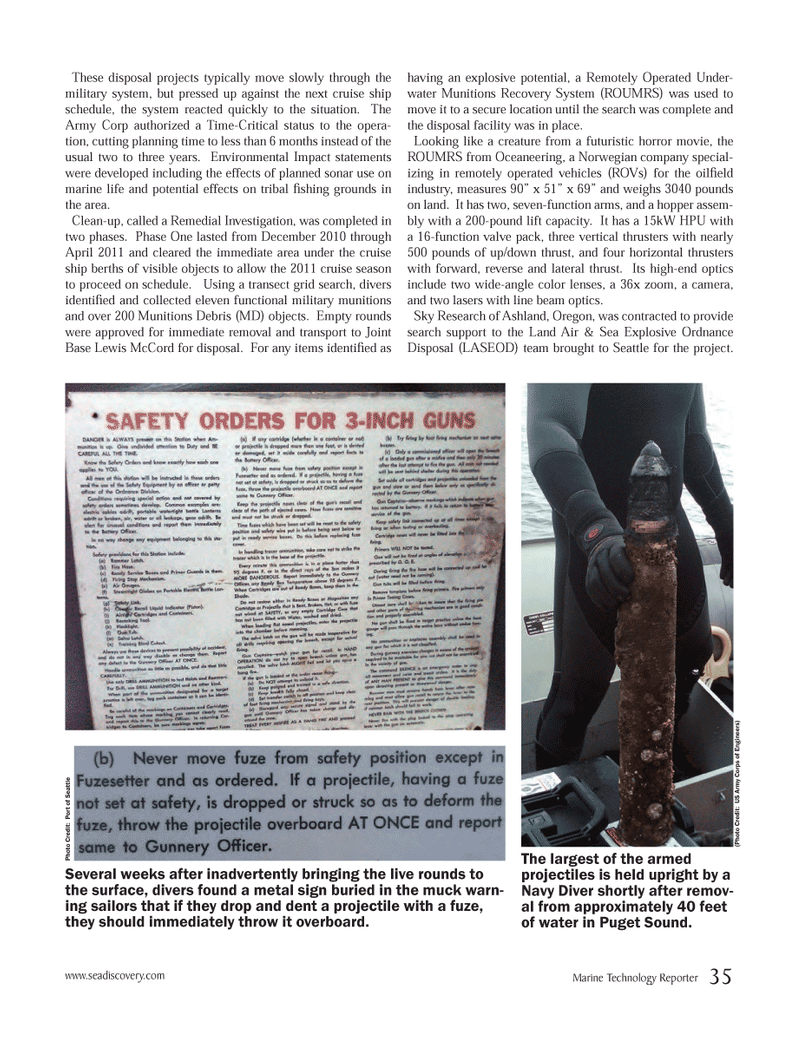
Page 35: of Marine Technology Magazine (June 2012)
AUV Arctic Operations
Read this page in Pdf, Flash or Html5 edition of June 2012 Marine Technology Magazine
These disposal projects typically move slowly through the military system, but pressed up against the next cruise ship schedule, the system reacted quickly to the situation. The Army Corp authorized a Time-Critical status to the opera- tion, cutting planning time to less than 6 months instead of the usual two to three years. Environmental Impact statements were developed including the effects of planned sonar use on marine life and potential effects on tribal Þ shing grounds in the area.Clean-up, called a Remedial Investigation, was completed in two phases. Phase One lasted from December 2010 through April 2011 and cleared the immediate area under the cruise ship berths of visible objects to allow the 2011 cruise season to proceed on schedule. Using a transect grid search, divers identiÞ ed and collected eleven functional military munitions and over 200 Munitions Debris (MD) objects. Empty rounds were approved for immediate removal and transport to Joint Base Lewis McCord for disposal. For any items identiÞ ed as having an explosive potential, a Remotely Operated Under- water Munitions Recovery System (ROUMRS) was used to move it to a secure location until the search was complete and the disposal facility was in place. Looking like a creature from a futuristic horror movie, the ROUMRS from Oceaneering, a Norwegian company special- izing in remotely operated vehicles (ROVs) for the oilÞ eld industry, measures 90Ó x 51Ó x 69Ó and weighs 3040 pounds on land. It has two, seven-function arms, and a hopper assem- bly with a 200-pound lift capacity. It has a 15kW HPU with a 16-function valve pack, three vertical thrusters with nearly 500 pounds of up/down thrust, and four horizontal thrusters with forward, reverse and lateral thrust. Its high-end optics include two wide-angle color lenses, a 36x zoom, a camera, and two lasers with line beam optics. Sky Research of Ashland, Oregon, was contracted to provide search support to the Land Air & Sea Explosive Ordnance Disposal (LASEOD) team brought to Seattle for the project. The largest of the armed projectiles is held upright by a Navy Diver shortly after remov- al from approximately 40 feet of water in Puget Sound. Several weeks after inadvertently bringing the live rounds to the surface, divers found a metal sign buried in the muck warn- ing sailors that if they drop and dent a projectile with a fuze, they should immediately throw it overboard. Photo Credit: Port of Seattle (Photo Credit: US Army Corps of Engineers) Marine Technology Reporter 35 www.seadiscovery.com MTR #5 (34-49).indd 35MTR #5 (34-49).indd 355/31/2012 10:18:53 AM5/31/2012 10:18:53 AM

 34
34

 36
36
